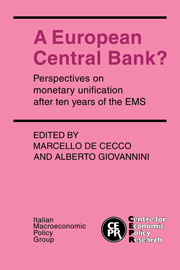Book contents
- Frontmatter
- Contents
- List of figures
- List of tables
- Preface
- List of conference participants
- 1 Does Europe need its own central bank?
- 2 Monetary policy, capital controls and seigniorage in an open economy
- 3 Seigniorage in Europe
- 4 Factor mobility, uncertainty and exchange rate regimes
- 5 Management of a common currency
- 6 The tastes of European central bankers
- 7 The costs and benefits of a European currency
- 8 The monetary unification process in nineteenth-century Germany: relevance and lessons for Europe today
- 9 The establishment of a central bank: Italy in the nineteenth century
- 10 The founding of the Fed and the destabilization of the post-1914 US economy
- 11 Panel discussion on the prospects for a European Central Bank
- Index
11 - Panel discussion on the prospects for a European Central Bank
Published online by Cambridge University Press: 05 February 2012
- Frontmatter
- Contents
- List of figures
- List of tables
- Preface
- List of conference participants
- 1 Does Europe need its own central bank?
- 2 Monetary policy, capital controls and seigniorage in an open economy
- 3 Seigniorage in Europe
- 4 Factor mobility, uncertainty and exchange rate regimes
- 5 Management of a common currency
- 6 The tastes of European central bankers
- 7 The costs and benefits of a European currency
- 8 The monetary unification process in nineteenth-century Germany: relevance and lessons for Europe today
- 9 The establishment of a central bank: Italy in the nineteenth century
- 10 The founding of the Fed and the destabilization of the post-1914 US economy
- 11 Panel discussion on the prospects for a European Central Bank
- Index
Summary
The Single European Act and monetary integration
The Single European Act of 17 February 1986 aims at the establishment of an area without internal frontiers permitting the free movement of goods, persons, services and capital by 1992 so as to improve the allocation of resources and put a seal, thirty-five years after the signing of the Treaty of Rome, on the integration of Europe. The liberalization of all capital movements – which will take place by 1990 – and the creation of a European financial market are therefore key objectives that will influence not only the conduct of monetary and credit policies in the coming years but also the structure of financial systems.
It should indeed be recognized that complete integration of national financial markets entails exchange rates remaining fixed. Otherwise, financial assets held in different currencies will not be perfectly substitutable, an indispensable condition for full integration. Financial integration itself calls for monetary convergence. In principle, sovereignty in monetary matters, which takes the form of autonomy in controlling the money supply and the exchange rate, is not compatible with the objective of creating by 1992 a single European financial market.
The benefits associated with currency integration depend in the final analysis on the ability to ensure, after a period of steady convergence, permanently stable exchange rates within the area and, ultimately, a single currency.
- Type
- Chapter
- Information
- A European Central Bank?Perspectives on Monetary Unification after Ten Years of the EMS, pp. 337 - 364Publisher: Cambridge University PressPrint publication year: 1989

